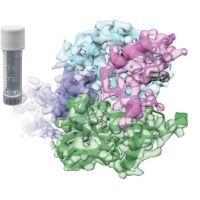Specification
| Organism | Homo sapiens (Human) |
| Expression Host | E.coli |
| Tag Info | N-terminal GST-tagged |
| Purity | Greater than 85% by SDS-PAGE |
| Uniprot ID | O60383 |
| Gene Names | GDF9 |
| Alternative Names | GDF9Growth/differentiation factor 9; GDF-9 |
| Expression Region | Full Length of Mature Protein(320-454aa ) |
| Molecular Weight | 42.5 kDa |
| Protein Sequence | GQETVSSELKKPLGPASFNLSEYFRQFLLPQNECELHDFRLSFSQLKWDNWIVAPHRYNPRYCKGDCPRAVGHRYGSPVHTMVQNIIYEKLDSSVPRPSCVPAKYSPLSVLTIEPDGSIAYKEYEDMIATKCTCR |
| Form | Liquid or Lyophilization |
| Buffer | The default storage buffer is Tris/PBS-based buffer, 5%-50% glycerol if the delivery form is liquid. The lyophilization buffer is Tris/PBS-based buffer, 6% Trehalose, pH 8.0 if the delivery form is lyophilized powder. Please contact us if you have any special requirment. |
| Reconstitution | Please reconstitute protein in deionized sterile water and we recommend that briefly centrifuge thevial prior to opening the vial .We recommend aliquot for long-term storage at -20℃/-80℃. |
Background
| Relevance | Required for ovarian folliculogenesis. Promotes primordial follicle development. Stimulates granulosa cell proliferation. Promotes cell transition from G0/G1 to S and G2/M phases, through an increase of CCND1 and CCNE1 expression, and RB1 phosphorylation. It regulates STAR expression and cAMP-dependent progesterone release in granulosa and thecal cells. Attenuates the suppressive effects of activin A on STAR expression and progesterone production by increasing the expression of inhibin B. It suppresses FST and FSTL3 production in granulosa-lutein cells. |
| Involvement in Disease | Altered GDF9 function may be involved in ovarian disorders. Rare variants in GDF9 have been found in patients with premature ovarian failure and mothers of dizygotic twins. |
| Subcellular Location | Secreted |
| Protein Families | TGF-beta family |
| Tissue Specificity | GDF9 |
QC Data
| Note | Please contact us for QC Data |
| Product Image (Reference Only) |  |

